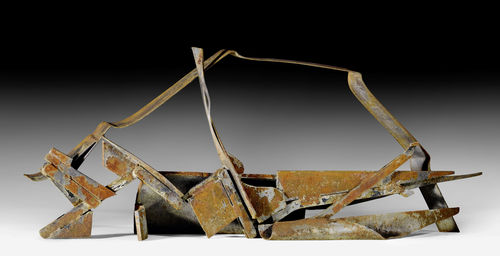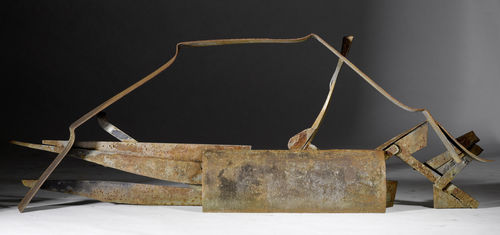
Lot 3444 - Z40 PostWar & Contemporary - Saturday, 25. June 2016, 02.00 PM
ANTHONY CARO
(New Malden 1924–2013 London)
Table Piece CCLXXXIX (Reno). 1975/76.
Rusted steel, lacquered.
64.8 x 172.1 x 22.9 cm.
Provenance:
- Acquired from Galerie André Emmerich, Zurich/New York, by the present owner in 1978.
- Since then private collection Switzerland.
Literature: Blume, Dieter: Anthony Caro. Catalogue raisonée, vol. I. Table and related sculptures 1966 - 1978, Cologne 1981, no. 296 (with ill.).
Exhibition: 1978 Zurich, Anthony Caro. Galerie André Emmerich, 31 March - 13 May 1978.
In the 1960s, Anthony Caro turned to Abstract Art and developed, amongst other things, his Table Pieces, one of which we are offering at auction here. They represent a conscious decision in favour of smaller sculpture; the development of floor to table sculpture in which the table becomes part of the work. The early Table Pieces always have an element which extends over the table, so that they cannot be placed on the floor. However, even the works from the 1970s, such as this one, only function at their scale when they are placed on a table. The table, however, has not been converted indirectly into a plinth, but rather an important component of the piece.
With his abstract sculptures, the artist forms the space and, at the same time, the void; he controls the dynamic and statics of the work. The devising and configuration of the form is the very core and quintessence of sculpture – it is not a metaphorical allusion or association. "He obliges the viewer to actively engage, because each object offers itself as a new experience of perception" (cit.: Skulptur. Die Moderne 19. und 20. Jahrhundert, vol. IV, Cologne 1986, p. 214).
The shift towards steel in the middle of the first half of the 20th century, when up to that point sculptures had been made in stone, offered sculptors an unimagined freedom in the creation of forms, since they no longer had to submit to the structural features of the stone. By welding, riveting, etc., they could shape the malleable material and assemble it according to their own ideas. Thus the production process became increasingly important.
In Caro’s works this is forcefully demonstrated: the individual elements, from which our Table Piece has been constructed, can be clearly identified through, for example, the welded seams, which means that each individual piece is exactly in the place where Caro wanted it to be. The production process becomes a more important component of the sculpture and establishes its uniqueness: "The accumulation of industrial parts, [...], allows a direct and spontaneous work process, not dissimilar to musical improvisation. It is worth noting that the sculptures are always formed directly from the material, without preparatory sketches or models." (cit.: Blume, Dieter: Anthony Caro. Catalogue raisonnée, vol. II. Table and related sculptures 1979-1980, Cologne 1981, p. 5). Caro himself commented on the production process: "Often many months go by before I see them again ... When I come to take a look at them, the umbilical cord which held me to them has been cut and I feel free to make very radical changes ... I believe that working in this fashion helps to keep spontaneity and freshness in my work." (ibid, p. 11)
- Acquired from Galerie André Emmerich, Zurich/New York, by the present owner in 1978.
- Since then private collection Switzerland.
Literature: Blume, Dieter: Anthony Caro. Catalogue raisonée, vol. I. Table and related sculptures 1966 - 1978, Cologne 1981, no. 296 (with ill.).
Exhibition: 1978 Zurich, Anthony Caro. Galerie André Emmerich, 31 March - 13 May 1978.
In the 1960s, Anthony Caro turned to Abstract Art and developed, amongst other things, his Table Pieces, one of which we are offering at auction here. They represent a conscious decision in favour of smaller sculpture; the development of floor to table sculpture in which the table becomes part of the work. The early Table Pieces always have an element which extends over the table, so that they cannot be placed on the floor. However, even the works from the 1970s, such as this one, only function at their scale when they are placed on a table. The table, however, has not been converted indirectly into a plinth, but rather an important component of the piece.
With his abstract sculptures, the artist forms the space and, at the same time, the void; he controls the dynamic and statics of the work. The devising and configuration of the form is the very core and quintessence of sculpture – it is not a metaphorical allusion or association. "He obliges the viewer to actively engage, because each object offers itself as a new experience of perception" (cit.: Skulptur. Die Moderne 19. und 20. Jahrhundert, vol. IV, Cologne 1986, p. 214).
The shift towards steel in the middle of the first half of the 20th century, when up to that point sculptures had been made in stone, offered sculptors an unimagined freedom in the creation of forms, since they no longer had to submit to the structural features of the stone. By welding, riveting, etc., they could shape the malleable material and assemble it according to their own ideas. Thus the production process became increasingly important.
In Caro’s works this is forcefully demonstrated: the individual elements, from which our Table Piece has been constructed, can be clearly identified through, for example, the welded seams, which means that each individual piece is exactly in the place where Caro wanted it to be. The production process becomes a more important component of the sculpture and establishes its uniqueness: "The accumulation of industrial parts, [...], allows a direct and spontaneous work process, not dissimilar to musical improvisation. It is worth noting that the sculptures are always formed directly from the material, without preparatory sketches or models." (cit.: Blume, Dieter: Anthony Caro. Catalogue raisonnée, vol. II. Table and related sculptures 1979-1980, Cologne 1981, p. 5). Caro himself commented on the production process: "Often many months go by before I see them again ... When I come to take a look at them, the umbilical cord which held me to them has been cut and I feel free to make very radical changes ... I believe that working in this fashion helps to keep spontaneity and freshness in my work." (ibid, p. 11)
CHF 40 000 / 60 000 | (€ 41 240 / 61 860)
Sold for CHF 30 500 (including buyer’s premium)
All information is subject to change.

